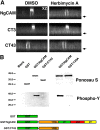Transcytosis of NgCAM in epithelial cells reflects differential signal recognition on the endocytic and secretory pathways
- PMID: 16087710
- PMCID: PMC2171499
- DOI: 10.1083/jcb.200506051
Transcytosis of NgCAM in epithelial cells reflects differential signal recognition on the endocytic and secretory pathways
Abstract
NgCAM is a cell adhesion molecule that is largely axonal in neurons and apical in epithelia. In Madin-Darby canine kidney cells, NgCAM is targeted to the apical surface by transcytosis, being first inserted into the basolateral domain from which it is internalized and transported to the apical domain. Initial basolateral transport is mediated by a sequence motif (Y(33)RSL) decoded by the AP-1B clathrin adaptor complex. This motif is a substrate in vitro for tyrosine phosphorylation by p60src, a modification that disrupts NgCAM's ability to interact with clathrin adaptors. Based on the behavior of various NgCAM mutants, it appears that after arrival at the basolateral surface, the AP-1B interaction site is silenced by phosphorylation of Tyr(33). This slows endocytosis and inhibits basolateral recycling from endosomes, resulting in NgCAM transcytosis due to a cryptic apical targeting signal in its extracellular domain. Thus, transcytosis of NgCAM and perhaps other membrane proteins may reflect the spatial regulation of recognition by adaptors such as AP-1B.
Figures








Similar articles
-
Analyzing the role of AP-1B in polarized sorting from recycling endosomes in epithelial cells.Methods Cell Biol. 2015;130:289-305. doi: 10.1016/bs.mcb.2015.03.023. Epub 2015 Jun 11. Methods Cell Biol. 2015. PMID: 26360041
-
The kinesin KIF16B mediates apical transcytosis of transferrin receptor in AP-1B-deficient epithelia.EMBO J. 2013 Jul 31;32(15):2125-39. doi: 10.1038/emboj.2013.130. Epub 2013 Jun 7. EMBO J. 2013. PMID: 23749212 Free PMC article.
-
Galectin-4-mediated transcytosis of transferrin receptor.J Cell Sci. 2014 Oct 15;127(Pt 20):4457-69. doi: 10.1242/jcs.153437. Epub 2014 Sep 1. J Cell Sci. 2014. PMID: 25179596 Free PMC article.
-
Recycling of galectin-3 in epithelial cells.Eur J Cell Biol. 2015 Jul-Sep;94(7-9):309-15. doi: 10.1016/j.ejcb.2015.05.004. Epub 2015 Jun 1. Eur J Cell Biol. 2015. PMID: 26059399 Review.
-
Membrane traffic in polarized epithelial cells.Curr Opin Cell Biol. 2000 Aug;12(4):483-90. doi: 10.1016/s0955-0674(00)00120-4. Curr Opin Cell Biol. 2000. PMID: 10873817 Review.
Cited by
-
Assembly and maintenance of nodes of ranvier rely on distinct sources of proteins and targeting mechanisms.Neuron. 2012 Jan 12;73(1):92-107. doi: 10.1016/j.neuron.2011.10.016. Neuron. 2012. PMID: 22243749 Free PMC article.
-
Mutation conferring apical-targeting motif on AE1 exchanger causes autosomal dominant distal RTA.J Am Soc Nephrol. 2012 Jul;23(7):1238-49. doi: 10.1681/ASN.2012020112. Epub 2012 Apr 19. J Am Soc Nephrol. 2012. PMID: 22518001 Free PMC article.
-
CD13 orients the apical-basal polarity axis necessary for lumen formation.Nat Commun. 2021 Aug 4;12(1):4697. doi: 10.1038/s41467-021-24993-x. Nat Commun. 2021. PMID: 34349123 Free PMC article.
-
Vectorial insertion of apical and basolateral membrane proteins in polarized epithelial cells revealed by quantitative 3D live cell imaging.J Cell Biol. 2006 Mar 27;172(7):1035-44. doi: 10.1083/jcb.200512012. J Cell Biol. 2006. PMID: 16567501 Free PMC article.
-
Axonal targeting of Trk receptors via transcytosis regulates sensitivity to neurotrophin responses.J Neurosci. 2009 Sep 16;29(37):11674-85. doi: 10.1523/JNEUROSCI.1542-09.2009. J Neurosci. 2009. PMID: 19759314 Free PMC article.

